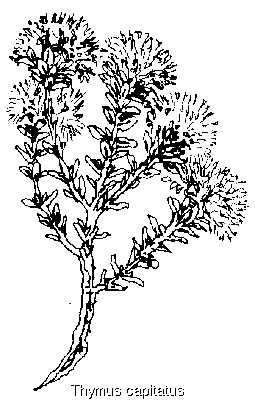THYME
(Thymus capitatus)

Appearance
A compact aromatic cushion-like shrublet with narrow glandular
leaves. The pink flowers appear between May and October grouped in
dense rounded terminal heads.
Habitat
Thyme is one of the dominant plants of garigue vegetation and is
common all over Cyprus from sea level to 2,900 ft on dry rocky slopes
and waste ground, occasionally on sand dunes or rocks by the sea. The
rounded shape of the plant acts to reduce water loss to a minimum allowing
it to survive long periods of drought undamaged.
Uses and Properties
Thyme is an excellent honey-yielding plant. The
plant was used as an incense in temples, and in fact its name derives
from the Greek name "thymon" which means to fumigate. Thyme is rich in
volatile oil (thyme oil) and has been widely used in medicine and
perfumery since ancient times. It was used by the Egyptians as an
aroma and for embalming the dead. Roman soldiers hoped to gain courage
and strength by bathing in water containing thyme. A beer and thyme soup
is reputed to be a cure for shyness. The antiseptic properties and pleasant
smell of thyme oil make it an ideal ingredient for cough syrups,
toothpastes and soaps. It is also widely used in modern perfumery and
cosmetics and as a culinary herb.




